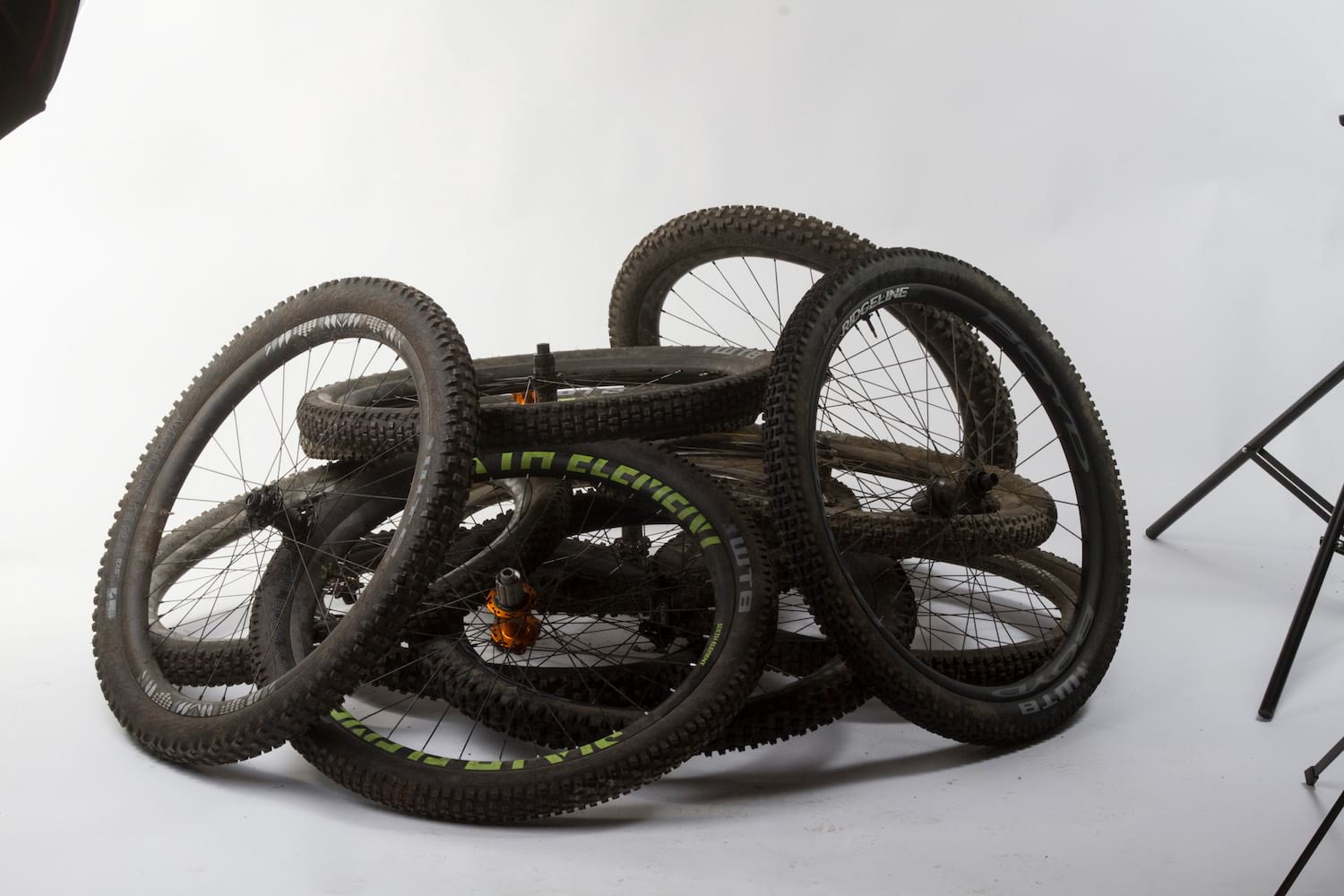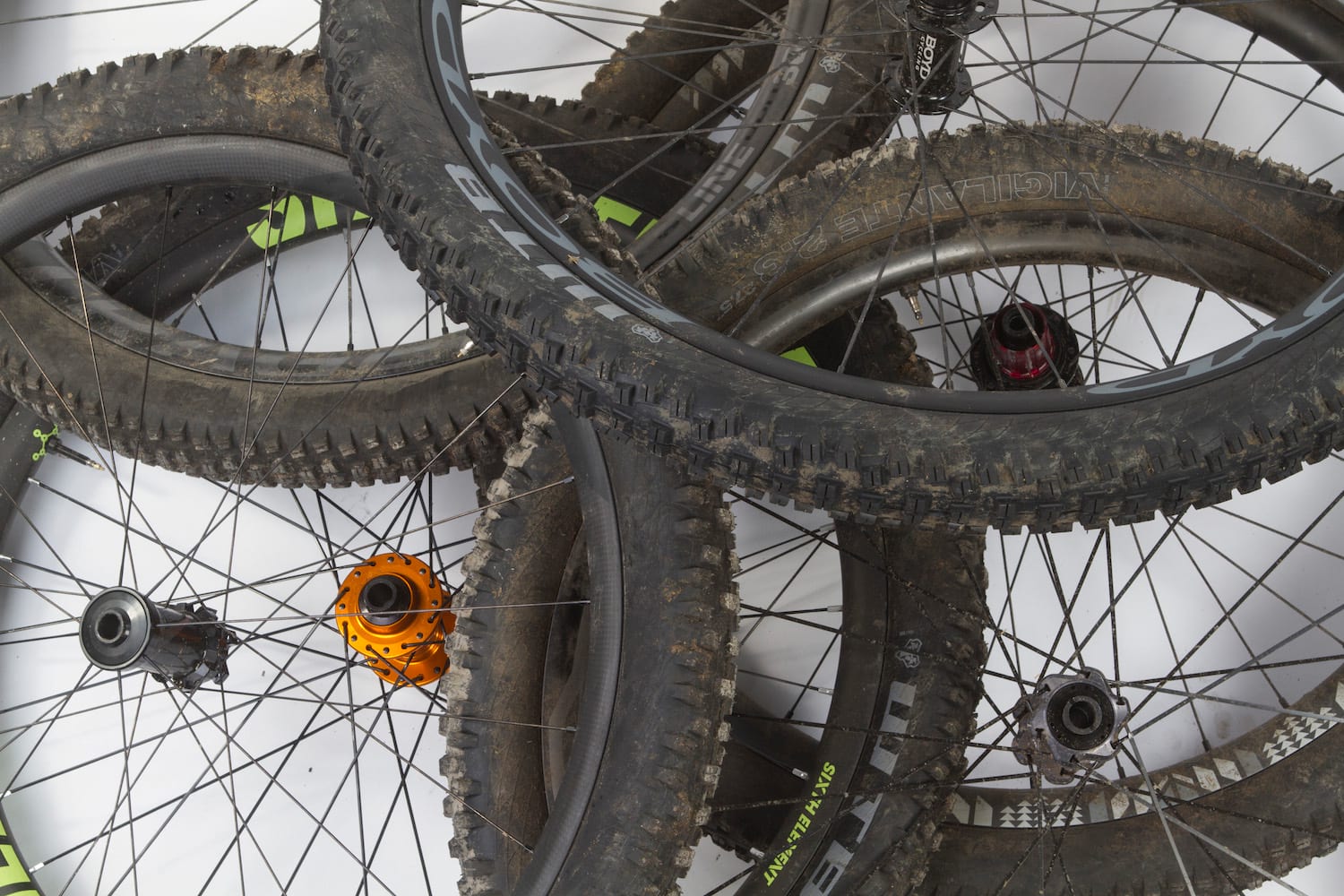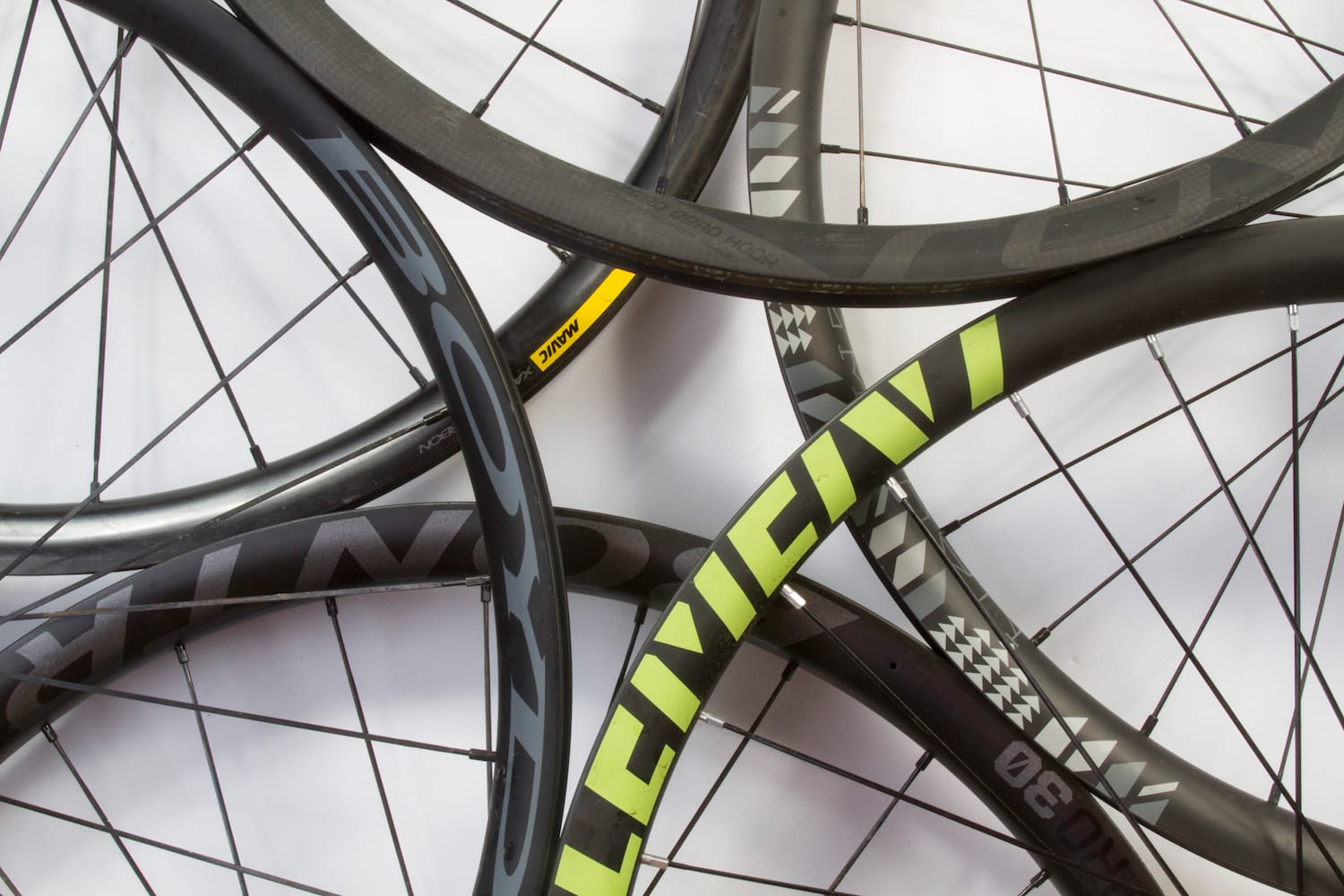Carbon wheels are creeping down in price, but are they worth the outlay? David Hayward and the team have been testing six sets under £1500 to see how they compare.
It’s often said that wheels are the best place on a bike to shed weight, so we picked six sub-£1,500 carbon fibre, Boost-spaced wheelsets to put to the test. Some of them are quite far under that budget, with a couple right around £900. The lightweight wheels in this test are (for most people) arguably on their way toward diminishing returns, but there’s more to a wheel than weight. Other factors bring significant differences to bear, and we’ve worked on eking them out.
Reviewing high-end bike components can be rife with subjectivity. There were a few things I was initially wrong about during the test, such as how quickly a particular freehub picked up, or how compliant a given wheel was. Sometimes my first impressions were corrected later by a look at cold hard numbers, sometimes by a bit more riding, but mostly by back-to-back testing.

Most riders, me included, could put a wheelset on and ride it one day, then another the next, and not properly feel the difference. Varying trail conditions, weather, sleep patterns, diet, moods and energy levels are all factors that can scrub out perceptible differences between similar bits of kit, or cause us to misattribute them.
There were differences in the feel of these wheelsets that I’d normally chalk up to having a good or bad riding day. Run the same wheelsets back-to-back in one session on the same bike though, and those differences are shown plainly. That’s exactly what we’ve been doing, with several riders recording impressions.
We subjected all of these wheels to the same bikes, the same tyres, same air pressures, riders, trails, weather conditions and abuse, all the while keeping and comparing notes. It’s given us an insight into wheel performance that you just don’t get from testing a new wheelset in isolation.

We settled on three category winners. In selecting the easiest wheels to live with, the main factors we’ve considered are serviceability, warranty support, and lack of proprietary or obscure standards. The most comfortable wheelset was selected by assessing ride quality in back-to-back comparative testing. Best value was selected on the basis of not just price, but ride quality, set-up, durability and servicing set against that.
We subjected all of these wheels to the same bikes, the same tyres, same air pressures, riders, trails, weather conditions and abuse
None of these are bad wheelsets to ride, and none are particularly cheap. If you’re a recreational mountain biker and have this kind of cash to put down on wheels, you’re probably not going to have a terrible time on any of them. However these reviews should help you find the best possible wheels for your particular kind of riding.

Step Inside My Lab
There’s no such thing as the best wheel, but there will be ones better suited to you and your riding. For instance, if you’re more aggressive in corners, a wider rim that squares off tread and increases tyre volume might be useful. Conversely if you’re a high mileage cross-country rider or into climbing, wheels with thinner, lighter rims will help you accelerate faster. If you like to straight-line everything on descents it might be that heavier rims and tyres work better to keep you on course.
The total weight differences between wheelsets we tested are only around 300g, with the lightest at 1,537g, and the heaviest at 1,783g (both excluding tyres, discs and cassettes). The lighter your wheels, the more responsive bike handling gets – partly because the lower amount of rotating mass will accelerate and slow down more easily.
It’s often said that wheels are the best place on a bike to shed weight
Overall weight isn’t the only significant thing though, but also how that weight is distributed. The further away from the axle any mass is, the more inertia it’ll have – consequently storing higher amounts of energy and generating higher gyroscopic forces. This is difficult to explain in such limited space, but what it means in practice is that when you turn your bars or lean your bike at speed, the wheels resist. Two wheelsets of equal weight will handle differently if one has more of that weight in the rims. The most effective places to shed weight on a wheel are from the outside in, with tyres the most and hubs the least impactful.

There’s also the way the wheels are built. It used to be that wheels with carbon fibre rims were super stiff and harsh, but manufacturers seem to have backed that off a bit and made things a little more compliant. As we’ve found in this test, fewer and lighter gauge spokes, along with differing hub geometry and rim layups, can completely change the feel of one wheel compared to another.
Most of the rims on test have hookless beads, which means unlike rims with bead hooks they don’t have a weak point where thinner sidewall material meets the rim bed. Consequently, while still not indestructible, modern carbon rims are much better at soaking up impacts than their predecessors.
Rear hub engagement is another factor we examined, with smaller engagement angles reducing dead stroke, which is the free movement between a crank starting to turn and the freehub pawls engaging to drive the rear wheel (recognisable by that clunk felt through your feet).

Engagement angles of these rear hubs ranged from 2.4° (150 teeth, RSP/Chosen) to 8.2° (44T, Sixth Element/Hope). That may seem a large range, but at the end of a 175mm crank it equals a dead stroke range of just 3.6mm to 12.5mm. Those are noticeable differences, but considering some cheaper hubs can give a dead stroke of up to 30mm, all of these wheels are fast to pick up pedal input. If you do a lot of technical uphills, or tight, thrutchy trails, the quickest engagement might be worthwhile, but for most riders all of these wheelsets will be sufficient.
WTB was kind enough to hook us up with a heap of tyres for this: 2.3in tough casing, High Grip Vigilantes for the fronts, and 2.3in tough casing, fast rolling Trail Boss tyres for the backs. To give every wheel a good clattering, I ran every tyre at 17psi, making sure to repeat the same trails for each wheelset.

None of the tyres went on entirely without levers, even with our best burly-handed tubeless experts on it. On set-up day I thought my thumbs might fall off. It used to be that you didn’t want tyre levers anywhere near a carbon rim as early models seemed to have a reputation for cracking if you looked at them too hard, but designs have moved on parsecs. I mean light years. Many tyre levers died to bring you this information.
Best Value: Bontrager Line Pro 30
- Price: £899
- From: Trek Bikes

“Bontrager’s Line Pro 30 Carbon wheels are among the lightest in this grouptest, yet also some of the cheapest. That can partly be explained by the fact Bontrager is owned by Trek, and as such gets to exploit massive economies of scale. This also means that the wheels are full of stuff that Bontrager and Trek have developed and patented themselves, though of course with the same engineering goals of other companies. Most carbon fibre parts are made in roughly the same way: sheets of woven fibre are cut, laid up, then shaped with various moulds and mandrels as resin cures around them. Particular methods might be unique and patentable, but there are many precise routes to plastic parts with very high tensile strength in multiple directions. Everyone manufacturing in carbon wants to prevent…” read the full review here.
Easiest To Live With: Sixth Element Race SE 34.28
- Price: £1228 (as tested)
- From: Sixth Element

“I have a secret. Despite building a hefty reputation for smashing wheels four years ago, and becoming Singletrack’s go-to tester for tubeless rim protection systems, I don’t really damage wheels much any more. Over the past year, I’ve (*lowers voice to a whisper*) developed a lot more finesse, and for most of 2017 I’ve been riding at low psi with no rim protection. Of course, putting this in print means I might immediately start smashing wheels, throwing myself from the bike, possibly wedging one or both feet firmly in my mouth, but I’ll take the chance for you. I had wondered how these wheels in particular would do (spoiler: they did fine). It’s not the first time we’ve ridden Sixth Element wheels, and we’ve broken a couple of…” read the full review here.
Most Comfortable: Mavic XA Pro Carbon
- Price: £1495
- From: Mavic

“Occasionally in this job, you hear pros talking about wheels. One was a mechanic claiming their rider disliked asymmetric rims and could feel the difference. Another was a racer asking “You know when you’re cornering and can feel every spoke loading and unloading?” and I, along with the person they were addressing, was thinking “…er, no?”. At the start of this test a friend said “a wheel’s a wheel, innit?”, and I found myself desperately hoping that wasn’t true. After all, I was testing six pairs of them. “They went round and didn’t break,” doesn’t differentiate much. Fortunately, nothing has demonstrated how different wheels can be to the extent these Mavics have. They’re unlike anything else in the grouptest, and during testing revealed some interesting…” read the full review here.
The Verdict
No rims were harmed in the making of this grouptest, and that honestly came as a surprise to all of us. Carbon rims haven’t previously been renowned for their durability, but thanks to hookless beads and new carbon layups, they now seem to be far surpassing alloy rims when it comes to resisting the average impact.
Of course, alloy and carbon have completely different failure modes: when carbon breaks, it’s usually done for. As this test has shown us though, the days of carbon rims breaking because you ran over a Jelly Baby are well and truly gone.
Wheel stiffness has been a big subject in marketing for the past few years, particularly with Boost hubs becoming a default standard, but stiffness isn’t the alpha and omega of wheels. The bike industry often seems to seesaw between selling stiffness or compliance in relation to a given component, but more stiffness doesn’t necessarily lead to the best handling wheelset.

In fact, some enduro racers and downhillers reportedly reduce their spoke tensions to change the way their wheels feel – and some wheelbuilders advise that this does nothing compared to spoke gauge, triangulation and rim material. Previously I thought the kind of sensitivity racers exhibit was beyond my ken, but riding and contrasting the Mavic, Roval and RSP wheels in particular has made me realise it’s not.
Take a look at the summary page for a quick overview of the three wheelsets not reviewed in print. The Boyds had excellent attention to detail and were quick to accelerate. Thanks to features like easily sourced spokes and ingenious valve nuts, if it weren’t for the US-based warranty they’d have been in the running for easiest to live with. The Rovals are stiff and probably best suited to heavier riders or smooth trails, but on rocky natural rides felt less accurate overall. The RSP wheels rode excellently and comfortably on all trails; were it not for a single mechanical issue, they would have been a shoo-in for best value.
We’ve come out of this with the knowledge that wheelsets are less subjective than some of us thought. In all six wheelsets, we found massive variations in performance and feel, and the positives didn’t necessarily correspond to higher prices.
Boyd Ridgeline
- Price: $1650 USD
- From: Boyd Cycling

“How much difference can wheel weight really make, out in the real world? I try to test blind (Ed: not that blind we hope!), tending not to look at numbers until I’ve ridden something and formed impressions. Sometimes I’m wrong, and looking at the numbers corrects me. Sometimes though, the difference is obvious, as with these. On a 20% road gradient near home, I realised I was pushing slightly higher gears than with most other wheelsets on the same bike…” read the full review here.
Roval Traverse SL Fattie
- Price: £1320
- From: Specialized

“Those of us above a certain age will know that, thanks to the internet, the Yellow Pages is now a shadow of its former self. In 2017 they are mere pamphlets compared to the weighty tomes of yore, and strongmen in leopard print underpants would just look silly ripping them apart on stage. Perhaps in the 21st century, they could replace that feat of strength with getting tubeless tyres off these Roval wheels. I’ve had to do that quite a lot, but it’s my own fault. Kinda. Coming in under the Specialized umbrella, Roval is the name you’ll see adorning the rims and hubs used on…” read the full review here.
RSP Calavera
- Price: £919.98
- From: Raleigh

“A new carbon wheel offering from Raleigh Special Products (RSP), the Calavera comes with a burly-looking rim that features a generous 28mm depth, and a 28mm internal width that will suit tyres up to about 2.5in wide. Designed to be a tough, stiff and durable wheelset, the Calavera is laced with 32 standard J-bend spokes and brass nipples, and rolls on sealed bearing Chosen hubs with a ridiculously fast 150pt freehub mechanism. As the second cheapest wheels in the group test (just beaten by the Bontrager Line Pro 30), the RSP Calavera is almost 600 quid less than the most expensive wheels we tested. Do they feel 600 quid cheaper though?” Read the full review here.






